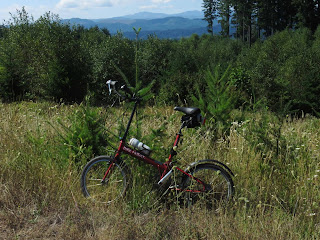Much of the trail between Banks and Vernonia was lined with ferns and moss-covered trees.
Sunday night, we left Portland and headed southeast. We had a cabin for two nights at La Pine State Park, south of Bend. On Highway 20, between the town of Sisters and Bend, the sun dropped below the horizon and we got a great view of the Sisters (the mountains) and Broken Top.
Both of us were still struggling with the time change, so we woke up at a completely unreasonable hour and laid there in our cabin, waiting for the sun to come up. When it was light enough, we went out to explore the park and were rewarded with this view of the Deschutes River and Newberry Crater in the distance. We hiked a short ways down the river, enjoying the cool morning.We met exactly one other person, a birder, who was out on the trail. He pointed us towards this bald eagle, keeping watch over the river.
After breakfast in La Pine, we drove up to Newberry Crater, which is a caldera similar to, but smaller than, Crater Lake. This picture is of the obsidian flow. The entire hillside in this picture is made up of chunks of obsidian, which is volcanic glass. This flow was formed about 12,000 years ago.
A closeup of the obsidian.
The view of Paulina Lake from Paulina Peak. The Sisters are in the background on the left (click to enlarge).
Rabbitbrush (I'm not sure of the genus and species) at Lava Butte, another section of Newberry Crater National Monument. Again, the Sisters are in the background.
We did a ranger-led hike in a lava tube at Lava Butte. I've been in lava tube caves before in Idaho and Arizona, but they were completely dry. This one actually has some water in it and, rock-eating bacteria!. How cool is that!
After we left La Pine State Park, we drove to Corvallis to see more friends. The next day, we headed out to the coast. This is Cape Lookout State Park.Several years ago, I read about Oswald West State Park in a National Geographic Adventure Magazine. We never made it out there when we lived in Oregon, but we stopped this time. Getting to the beach requires walking about half a mile through a pocket of the giant trees, moss, and ferns of coastal old growth forest. It also has giant logs that have washed up onshore, presumably during winter storms.
Surfers headed out to catch waves at Oswald West State Park. Even in the summer, the water is cold enough to require wet suits.
We ended our day on the coast with a yurt at Fort Stevens State Park, located at the mouth of the Columbia River.
Pelicans flying in the setting sun.
Sunset on the dunes at the mouth of the Columbia.
















No comments:
Post a Comment